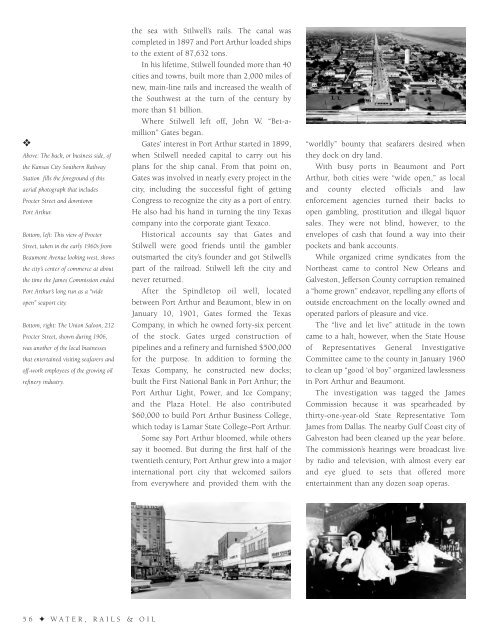Water Rails & Oil - Historic Mid & South Jefferson County
An illustrated history of the Mid and South Jefferson County area, paired with the histories of companies, families and organizations that make the region great.
An illustrated history of the Mid and South Jefferson County area, paired with the histories of companies, families and organizations that make the region great.
You also want an ePaper? Increase the reach of your titles
YUMPU automatically turns print PDFs into web optimized ePapers that Google loves.
❖<br />
Above: The back, or business side, of<br />
the Kansas City <strong>South</strong>ern Railway<br />
Station fills the foreground of this<br />
aerial photograph that includes<br />
Procter Street and downtown<br />
Port Arthur.<br />
Bottom, left: This view of Procter<br />
Street, taken in the early 1960s from<br />
Beaumont Avenue looking west, shows<br />
the city’s center of commerce at about<br />
the time the James Commission ended<br />
Port Arthur’s long run as a “wide<br />
open” seaport city.<br />
Bottom, right: The Union Saloon, 212<br />
Procter Street, shown during 1906,<br />
was another of the local businesses<br />
that entertained visiting seafarers and<br />
off-work employees of the growing oil<br />
refinery industry.<br />
the sea with Stilwell’s rails. The canal was<br />
completed in 1897 and Port Arthur loaded ships<br />
to the extent of 87,632 tons.<br />
In his lifetime, Stilwell founded more than 40<br />
cities and towns, built more than 2,000 miles of<br />
new, main-line rails and increased the wealth of<br />
the <strong>South</strong>west at the turn of the century by<br />
more than $1 billion.<br />
Where Stilwell left off, John W. “Bet-amillion”<br />
Gates began.<br />
Gates’ interest in Port Arthur started in 1899,<br />
when Stilwell needed capital to carry out his<br />
plans for the ship canal. From that point on,<br />
Gates was involved in nearly every project in the<br />
city, including the successful fight of getting<br />
Congress to recognize the city as a port of entry.<br />
He also had his hand in turning the tiny Texas<br />
company into the corporate giant Texaco.<br />
<strong>Historic</strong>al accounts say that Gates and<br />
Stilwell were good friends until the gambler<br />
outsmarted the city’s founder and got Stilwell’s<br />
part of the railroad. Stilwell left the city and<br />
never returned.<br />
After the Spindletop oil well, located<br />
between Port Arthur and Beaumont, blew in on<br />
January 10, 1901, Gates formed the Texas<br />
Company, in which he owned forty-six percent<br />
of the stock. Gates urged construction of<br />
pipelines and a refinery and furnished $500,000<br />
for the purpose. In addition to forming the<br />
Texas Company, he constructed new docks;<br />
built the First National Bank in Port Arthur; the<br />
Port Arthur Light, Power, and Ice Company;<br />
and the Plaza Hotel. He also contributed<br />
$60,000 to build Port Arthur Business College,<br />
which today is Lamar State College–Port Arthur.<br />
Some say Port Arthur bloomed, while others<br />
say it boomed. But during the first half of the<br />
twentieth century, Port Arthur grew into a major<br />
international port city that welcomed sailors<br />
from everywhere and provided them with the<br />
“worldly” bounty that seafarers desired when<br />
they dock on dry land.<br />
With busy ports in Beaumont and Port<br />
Arthur, both cities were “wide open,” as local<br />
and county elected officials and law<br />
enforcement agencies turned their backs to<br />
open gambling, prostitution and illegal liquor<br />
sales. They were not blind, however, to the<br />
envelopes of cash that found a way into their<br />
pockets and bank accounts.<br />
While organized crime syndicates from the<br />
Northeast came to control New Orleans and<br />
Galveston, <strong>Jefferson</strong> <strong>County</strong> corruption remained<br />
a “home grown” endeavor, repelling any efforts of<br />
outside encroachment on the locally owned and<br />
operated parlors of pleasure and vice.<br />
The “live and let live” attitude in the town<br />
came to a halt, however, when the State House<br />
of Representatives General Investigative<br />
Committee came to the county in January 1960<br />
to clean up “good ‘ol boy” organized lawlessness<br />
in Port Arthur and Beaumont.<br />
The investigation was tagged the James<br />
Commission because it was spearheaded by<br />
thirty-one-year-old State Representative Tom<br />
James from Dallas. The nearby Gulf Coast city of<br />
Galveston had been cleaned up the year before.<br />
The commission’s hearings were broadcast live<br />
by radio and television, with almost every ear<br />
and eye glued to sets that offered more<br />
entertainment than any dozen soap operas.<br />
56 ✦ WATER, RAILS & OIL
















